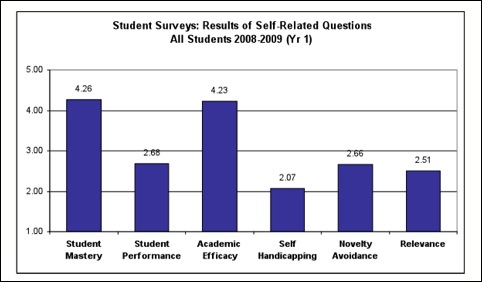The Patterns of Adaptive Learning Scales surveys are designed to examine the relationship between learning environments and students’ goal orientations, affect, and behaviors, as well as teachers’ goal orientations with their students. The results of the surveys help us understand the characteristics that students and teachers bring to the classroom and aid in our understanding of the environment they share (Midgley, Maehr, Hruda, Anderman, & Others, 2000).
We administered the PALS surveys to 321 students and 7 instructors in five different courses. Six of the surveys (1.9%) were discarded, and 27 surveys were returned by underage or non-participating students. Thus, a total of 288 student surveys were included in our analyses. Our initial analyses were mostly descriptive; however, we did perform some statistical tests for comparisons.
Key Findings:

• Students reported high mastery goal orientation (4.26/5) and lower performance goal orientation (2.68/5).
• Students perceive their teachers as having a mastery goal orientation (3.93/5) and not a performance goal orientation (1.87/5), and they perceived teachers as pressing them academically (3.74/5).
• Students report high self-efficacy (3.74/5) and low self-handicapping behaviors (2.06/5).
• Students were fairly neutral regarding novelty avoidance (2.66/5) and relevance of math to their career/future (2.51/5).
• Students report good past experiences in math—3.57/5 overall (Fall 2008 survey) and 3.88/5 in college math (Winter 2009 survey). Fewer than 20% of the students have repeated a math course in college.
• There were more males (59.7%) than females in our survey sample.
• Demographic information reveals that the majority of students are single (75%) and without dependents whose care they are primarily responsible for (85.4%).
• Most of the students (82.3%) work at a paying job, and 35% work more than 30 hours per week during their school semesters.
Available Reports:
PALS Fall 2009 Report